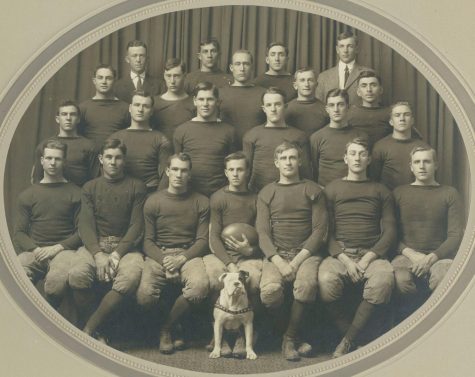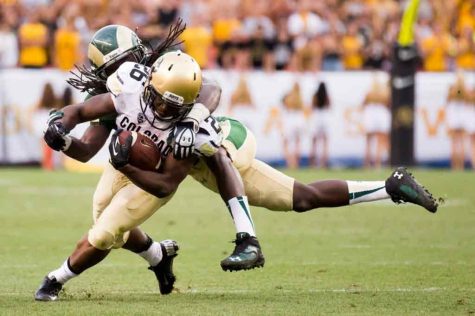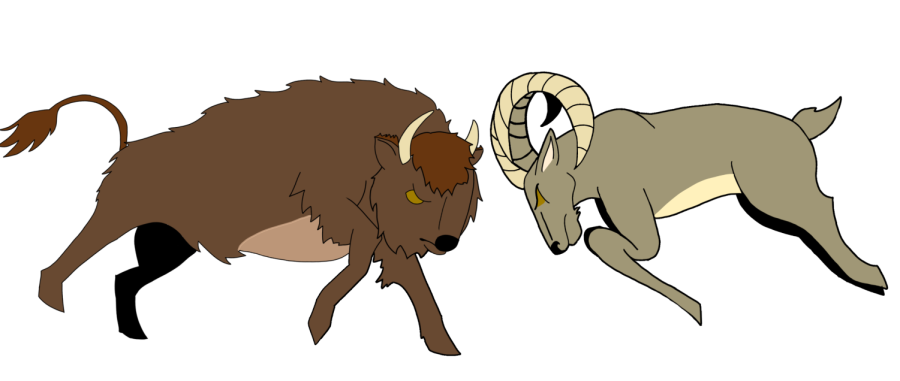Ad
Rams vs. Buffs: The History of the Legendary Rivalry
Graphic Ilustration of a buffalo and a ram. (Olive Mielke | College Avenue Magazine)
September 21, 2022
For as long as Colorado State University has existed, there has been a mutual rivalry with the University of Colorado Boulder. Promoted at academic conferences, on social media, and in athletic events for over a century, the rivalry is almost as old as Colorado itself. Although its origins have been largely forgotten, the early stories of the biggest Colorado athletic rivalry in history are remembered.
In 1870, the Colorado territorial legislature allocated money to create the Colorado School of Mines, the University of Colorado, and the Colorado Agricultural College, which would later become Colorado State University. CAC was the agrarian college in Fort Collins: horticulture and farm economy comprised two of the first six courses offered. More than 40 miles south, CU was built in Boulder, a prosperous, industrial mining town.
“Almost all of the folks that moved to [Fort Collins] were either farmers or ranchers,” says Meg Dunn, a member of the Fort Collins Historical Society board. “Boulder [was] benefitting from the mining that was going on around the state.”
In 1893, the Colorado Agricultural football team was formed with no head coach and a mere 18 players, according to CSU Athletics. The University of Colorado, whose football team was nicknamed the Colorado Silver and Gold, had formed a team in 1890 under similar circumstances: they had no head coach and few ready to play. Born of geographic proximity, athletic enthusiasm, and reputational differences that demanded a superior school, CAC initiated a football game against CU, which became the first display of rivalry between the schools.
Colorado Agricultural College fumbled. According to the American Football Database, CAC faced a miserable loss of 70-6 on February 10th, 1893.
Yet, Colorado Agricultural College continued to play the University of Colorado each year in what would later be called the Rocky Mountain Showdown. According to the American Football Database, in 1899, Colorado Agricultural College adopted the “Aggie” as their mascot, which was a colloquial term for “farmer.” Later, in 1909, both teams, joined by the Colorado School of Mines and Colorado College, were chartered into the Rocky Mountain Athletic Conference. Still, Colorado Agricultural College had not garnered a football win against the University of Colorado — until 1912.

That year, a member of the Alpha Pi Lambda fraternity introduced an English bulldog to CAC. As found in the Colorado State University archives, Peanuts the bulldog rose to fame after interrupting an early morning music performance on campus. Fascinated students accepted him as their unofficial mascot. Peanuts watched the Aggies win the Rocky Mountain Showdown in 1912, 1915, and 1916, and win the Rocky Mountain Athletic Conference football championship in 1915. He was the spirited cheerleader and good-luck charm for the Aggies against CU.
Rather, he was until 1918.
On the brisk morning of April 28th, 1918, Aggies found Peanuts dead on campus. A column in The Rocky Mountain Collegian reported that the beloved Peanuts had been poisoned. Rumors spread that a CU student had murdered Peanuts, riling up the Aggies for vengeance. In 1919, CAC swept the Rocky Mountain Showdown in a 49-7 victory. Peanuts’ death changed the rivalry’s tone — it was no longer just a football rivalry, but also a social rivalry.
The vicious social rivalry continued into the 1920s, culminating in 1923. CAC and CU prepared for the Rocky Mountain Showdown on Thanksgiving. The Collegian documented the Wednesday prior, in which a crowd of Aggies met at a chapel, brooms in hand, for an explosive pep rally led by the football team. They marched through Fort Collins, screaming from campus to the Northern Hotel, rallying for a win.
The writer for the story wrote for any disloyal Aggies: “May the turkey that he hopes to relish have the flavor of garlic and hay and stick in his throat like poison!”
Soon, however, the Rocky Mountain Showdown slowed down. In 1934, the University of Colorado adopted the Buffaloes as their mascot. Then, in 1935, Colorado Agricultural College became Colorado State College of Agricultural and Mechanical Arts, according to the Colorado State University’s Office of the President. Later, in 1957, Colorado A&M became Colorado State University. The period of continuous changes eventually led to a Rocky Mountain Showdown hiatus from 1959 to 1983, as both schools grappled with civil unrest.

“One big change during that time is that Fort Collins allowed alcohol in 1969 for the first time since 1896,” Dunn says.
The Fort Collins History Connection notes that lifting prohibition, combined with rapid population growth and continuous anti-war protests, culminated in tumultuous years in Fort Collins. In Boulder, residents faced similar unrest.
Without football games to rally behind, students sought an alternative: basketball. Between 1959 and 1983, the Aggies and Buffaloes met six times for basketball. While the Rocky Mountain Showdown continued sporadically between 1983 and 1995, then regularly again in 1996, the basketball teams met every year from 1991 to 2019.
In a 2011 interview for The Collegian, then-head coach of Colorado State University’s men’s basketball, Tim Miles, was asked about the previous year’s loss to CU. Miles said, “It’s CU. Anytime you lose to Colorado, you’re sick to your stomach.”
In 2015, CU and CSU leadership met to renew the Rocky Mountain Showdown past 2020. However, the negotiations failed. Rick George, the University of Colorado athletic director, would later tell The Denver Post that scheduling concerns and student reluctance to travel to Denver for the game contributed to his withdrawal from the football series.
The origins of the Colorado State vs. Colorado rivalry were, in George’s words, “dead.” But with a rich history of intense, encouraging competition behind the schools, the rivalry persisted. Quickly, the women’s volleyball teams began a new tradition: since 2019, they have competed annually for the Golden Spike Trophy. Students continued the rivalry, with each school perpetuating the most passionate in-state collegiate rivalry in Colorado’s history.
The University of Colorado and Colorado State University rivalry transcended casual football camaraderie and evolved into a multi-athletic and social rivalry of over 100 years. When it became apparent that the rivalry was not dead, the Rocky Mountain Showdown’s termination was quickly reversed. According to KRDO, The two football teams will meet again on Sept. 16, 2023, four years after their last game. With new head coaches, new players, and new fans, the Rocky Mountain Showdown has been revived — and the CSU vs. CU rivalry endures.



































